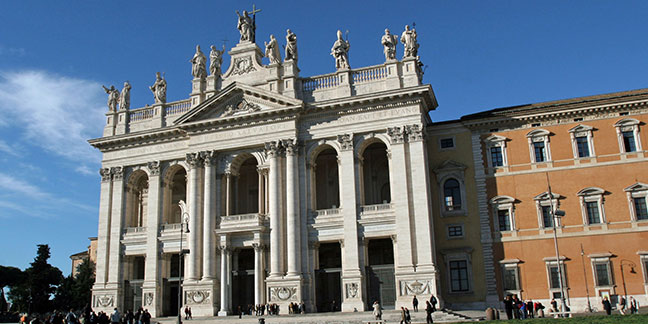 The feast of the Dedication of the Basilica of St. John Lateran is celebrated by the entire Church. It marks the dedication of the cathedral church of Rome by Pope Sylvester I in 324.
The feast of the Dedication of the Basilica of St. John Lateran is celebrated by the entire Church. It marks the dedication of the cathedral church of Rome by Pope Sylvester I in 324.
This church is the cathedra (or chair) of the bishop of Rome, who is the pope. A Latin inscription in the church reads: “omnium ecclesiarum Urbis et Orbis mater et caput.” Translated, this means, “The mother and head of all churches of the city and of the world.”
The basilica was originally named the Archbasilica of the Most Holy Savior.
However, it is called St. John Lateran because it was built on property donated to the Church by the Laterani family, and because the monks from the monastery of St. John the Baptist and St. John the Divine served it.
By honoring its dedication, the worldwide Church celebrates communion with the See of Peter, Pope Benedict XVI has noted. The architectural beauty and order of church buildings is intended to glorify God, but the real treasure of the Church is the temple built of “living stones” – the faithful – “and molded within by the Holy Spirit.”
— Catholic News Agency
What is a basilica?
There are four “major” or papal basilicas – all of which are in Rome. All other basilicas are called “minor” basilicas.
The Diocese of Charlotte has two minor basilicas: Mary, Help of Christians Abbey (better known as Belmont Abbey), and St. Lawrence Basilica in Asheville.
The Asheville basilica states on its website:
The term dates back to the early Greek and Roman times and referred to a type of public building. In the 4th century, basilicas began to be used as places of worship. It was during this time that construction of the greatest basilicas of Rome was started. Today, the term basilica is a special designation given by the pope to certain churches because of their antiquity, dignity, historical importance or significance as a place of worship.
To become a basilica, the church must have been consecrated. The liturgical rites (celebration of the Holy Eucharist, sacraments of penance and other sacraments) should also be executed in an exemplary way with fidelity to liturgical norms and the active participation of the people of God.
It should also have special significance in the diocese. St. Lawrence, with its unique dome, is the only church designed and built by the renowned Rafael Guastavino.
Because of the relationship between a basilica and the pope, basilicas have the responsibility to promote the study of the documents of the pope and the Holy See, especially those concerning the Sacred Liturgy.
Also, certain days in the liturgical year are to be celebrated with added solemnity, among them the Feast of the Chair of St. Peter (Feb. 22), the Solemnity of Sts. Peter and Paul (June 29), and the anniversary of the election or coronation of the supreme pontiff.
An outward sign and privilege that comes to a basilica is the honor and opportunity to display the seal of the papacy.
Virtual tours online
At www.vatican.va: Check out virtual 360-degree tours of St. Peter’s Basilica and St. John Lateran, along with other basilicas and chapels of the Vatican. Click on “Basilicas and Papal Chapels” on the bottom right of the page.
Did you know?
There are two kinds of basilicas in the Catholic Church: major (or papal) and minor. The Church’s four major basilicas are all in Rome. Besides St. John Lateran, there are St. Peter’s, St. Paul Outside the Walls and St. Mary Major.
Minor basilicas, on the other hand, are churches around the world designated by the pope that stand out because of their antiquity, dignity, historical importance, architectural and artistic worth, or sinificance to the Church. There are two minor basilicas in the Diocese of Charlotte: St. Lawrence Basilica in Asheville and Mary Help of Christians Abbey Basilica in Belmont.
— Catholic News Herald


